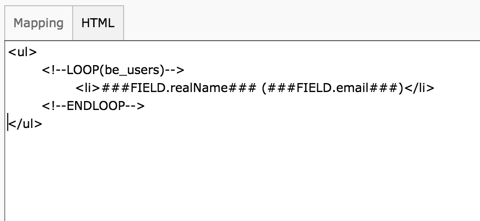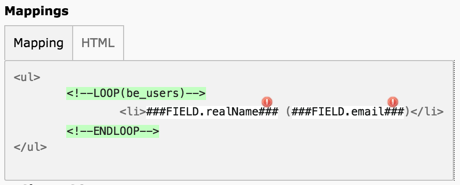DEPRECATION WARNING
This documentation is not using the current rendering mechanism and is probably outdated. The extension maintainer should switch to the new system. Details on how to use the rendering mechanism can be found here.
Preparing a template for display¶
The next step is to start preparing the display for the results of our query. To achieve this, create a new record of type Template-based Display. Just enter a title and save. You should have a screen that looks like this:

A Template Display element with just a title
The main action happens in the mapping "Fields". At the moment there's nothing we can do in the "Mapping" tab, but we can switch to the "HTML" tab and start defining a template for displaying the list of BE users. Enter the following HTML:
<ul>
<!--LOOP(be_users)-->
<li>###FIELD.realName### (###FIELD.email###)</li>
<!--ENDLOOP-->
</ul>
in the HTML tab.

Inserting the HTML code in the Template Display element
The basic idea is to display the BE users as a bulleted list.
So the first step is to open and close a <ul> tag. Inside that tag we
define a loop on the "be_users" table, using the syntax which is
explained in more details in the manual of the Template Display
extension. Inside the loop, we create a <li> tag for each user and
decided to display the name and the email side-by-side, the email
being wrapped in brackets.
We can move back the the "Mapping" tab. The HTML that we just entered is saved in the background. You should now have the following view:

The mapping tab with unmapped fields
As you can see that HTML was parsed and some elements were recognized and highlighted: the loop and the "field markers". Those markers are where the data from the database will come. They currently have warning icons over them because they are not yet related to a database field, even though the use the same name. In the current situation, the "Data Queries" record that we created in the previous step and the template are not related in any way.
In the next step we will define the actual content element and make the relation between the query and the template. For now you can save and close the "Template-based Display" record.